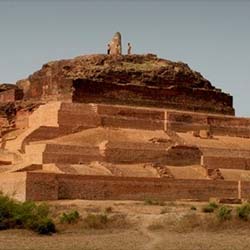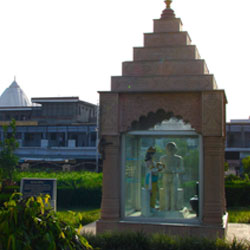
- Home
- Travel Packages
- Top Destination
-
Travel Attraction
By Category
Top Attraction

- Travel Agents
- Car Rentals
- Hotels

About Ahichhatra, Bareilly History Ahichhatra, located in Bareilly, Uttar Pradesh, is a historic site dating back to ancient times. It was once the capital of Northern Panchala, a region mentioned in the Mahabharata. The site has ruins of a fort, Buddhist stupas, and monasteries, dating back to the Mauryan and Kushan periods. Architecture and Design The architecture of Ahichhatra is a mix of Mauryan, Gupta, and Kushan styles. The fort ruins showcase the military architecture of the time, while the stupas and monasteries reflect the Buddhist influence in the region. Best Time to Visit Ahichhatra is best visited during the winter months, from October to March, when the weather is pleasant and ideal for exploring the archaeological site. October to March - Winter months with pleasant weather Cultural Significance Ahichhatra holds cultural significance as a historic site that dates back to ancient times. It is believed to have been a significant center for trade, religion, and politics in the region. Pilgrimage Practices Ahichhatra is not only a historic site but also a pilgrimage destination for Buddhists and followers of other religions. Pilgrims visit the stupas and monasteries to pay their respects and seek blessings. Dress Code and Etiquette Visitors to Ahichhatra are expected to dress modestly and respectfully, covering their shoulders and knees. It is also important to maintain silence and refrain from littering at the site. Activities and Experiences Visitors to Ahichhatra can explore the fort ruins, stupas, and monasteries, learning about the history and architecture of the site. Guided tours are available for a more in-depth experience. Art and Religious Symbols The stupas and monasteries at Ahichhatra are adorned with intricate carvings and religious symbols, showcasing the artistic and spiritual significance of the site. Visitors can admire the craftsmanship and symbolism in the architectural elements. Local Insights Locals in Bareilly hold Ahichhatra in high regard as a historic and religious site. They are proud of the rich heritage and cultural significance of the region, and are eager to share their knowledge and stories with visitors.
Explore More
About Digambar Jain Temple, Meerut History The Digambar Jain Temple in Meerut is a significant religious site for the Jain community in India. The temple has a rich history dating back several centuries, with the exact date of its construction unknown. It is believed to have been built during the reign of the Gupta dynasty. Over the years, the temple has undergone renovations and expansions, making it a prominent place of worship for Jains in the region. Architecture and Design The Digambar Jain Temple in Meerut showcases stunning architecture and intricate design elements. The temple features beautiful carvings, intricate sculptures, and detailed artwork that reflect the rich cultural heritage of the Jain community. The temple's design incorporates traditional Jain architectural styles, with a focus on symmetry, geometry, and spiritual symbolism. Best Time to Visit - The best time to visit the Digambar Jain Temple in Meerut is during the winter months, from October to March, when the weather is pleasant. - Avoid visiting during the summer months, from April to June, as the temperatures can be quite high and uncomfortable. Cultural Significance The Digambar Jain Temple holds immense cultural significance for the Jain community, serving as a place of worship, meditation, and spiritual reflection. It is a hub for religious ceremonies, festivals, and rituals that celebrate the teachings of Jainism and promote peace, harmony, and compassion. Pilgrimage Practices When visiting the Digambar Jain Temple, pilgrims are encouraged to engage in various practices such as meditation, prayer, and offering of prayers and donations. Pilgrims also participate in religious ceremonies and rituals that are performed by Jain priests to seek blessings and guidance from the divine. Dress Code and Etiquette Visitors to the Digambar Jain Temple are expected to dress modestly and respectfully, covering their shoulders and legs. It is customary to remove shoes before entering the temple premises as a sign of respect. Visitors are also encouraged to maintain silence and refrain from taking photographs inside the temple. Activities and Experiences Visitors to the Digambar Jain Temple can participate in a range of activities and experiences, including attending religious ceremonies, listening to spiritual discourses, and exploring the temple's stunning architecture and design. The temple also offers opportunities for meditation, prayer, and reflection in a serene and peaceful setting. Art and Religious Symbols The Digambar Jain Temple is adorned with intricate artwork and religious symbols that hold deep spiritual significance for the Jain community. The temple's walls, pillars, and ceilings are decorated with symbols such as the swastika, lotus, and other auspicious motifs that represent the core beliefs and values of Jainism. Local Insights Visitors to the Digambar Jain Temple in Meerut can gain valuable insights into the Jain community's rich cultural heritage, traditions, and practices. Local guides and priests are available to provide insights into the temple's history, architecture, and religious significance, offering a deeper understanding of Jainism and its teachings.
Explore More
Shri Digambar Jain Shravasti Teerth Kshetra
Shri Digambar Jain Shravasti Teerth Kshetra, Shravasti is one of the renowned places at the land of Lucknow. There is no denying the fact that your Teerth is completed if you haven’t been to Shri Digambar Jain Shravasti Teerth Kshetra. Topping it all, all over the world the Teerth Kshetra is the best and highly acknowledged shrines of Shravasti. It is also to be noted here that Shri Digambar Jain Shravasti Teerth Kshetra is erected in the sweet memory of Lord Sambhavnath. Also, one can witness and pray in front of the white image of the presiding deity that has been constructed in the padmasana posture. It is during the time of Lord Adhishvar that the history of this beautiful place lies in. If we dig more into the historical significance of the place, then the temple is said to be the consecrated terrestrial of four Kalyanakas of Lord Sambhavnath that are birth, chayan, attainment and diksha. Ashoka and King Samprati who happen to be the great Mauryan emperor had constructed a wide number of stupas and shrines on the holy land of Shravasti. It was during that period when a number of Muslim invaders were knocked down by the Jainis in order to keep the brilliance and magnificence of the pilgrimage locations in Shravasti. Best Time to Visit: Shri Digambar Jain Shravasti Teerth Kshetra, Shravasti can be visited anytime all around the year, but the best time recommended to visit this tourist place is in the winter season for obvious reasons. Right form the month of October to February, one can hassle-free and easily enjoy exploring Shri Digambar Jain Shravasti Teerth Kshetra, Shravasti. How to Reach: For the airplane lovers, the nearest airport happens to be Chaudhary Charan International Airport which is Lucknow’s major airport and is 170 kms away from Shravasti. The devotees who are coming from Agra, Bangalore, Mumbai, Delhi, and Chennai can easily pay their holy visit by getting down at Balrampur railway station that is the nearest railway station. It will take you for over 17 kilometers drive more to reach Shravasti. Or else, if you don’t want to get down at Balrampur railway station, then Gonda railway station is 50 kms away, you can get a cab or taxi from there to reach Shri Digambar Jain Shravasti Teerth Kshetra, Shravasti. Traveller Information: To let all our readers know, Shri Digambar Jain Shravasti Teerth Kshetra is such a tourist place that is open every day right from morning to evening. So, you can visit any time the entire day. Nearby Attractions: For all those who are travelling to Shri Digambar Jain Shravasti Teerth Kshetra, Shravasti can also go through and explore the nearby attractions of the place. Angulimal Stupa, Daen Mahamongkol, Miracle Stupa, Sravasti Stupas, Sahet Mahet Fort, Kali Mata Mandir, Shiv Mandir and Sammai Mata Mandir are some of the places one can explore along with Shri Digambar Jain Shravasti Teerth Kshetra.
Explore MoreMathura Goverdhan Barsana Car Tour
1 Day
Mathura - Vrindavan
5N/6D Spiritual Triangle with Naimisharanya
6 Days/ 5 Night
Lucknow - Ayodhya - Prayagraj - Varanasi - Sitapur
2D - 1N Agra Tour Package
2 Days/ 1 Night
Agra
Uttar Pradesh Spiritual Circuit-4N 5D
5 Days/ 4 Night
Ayodhya - Prayagraj - Varanasi